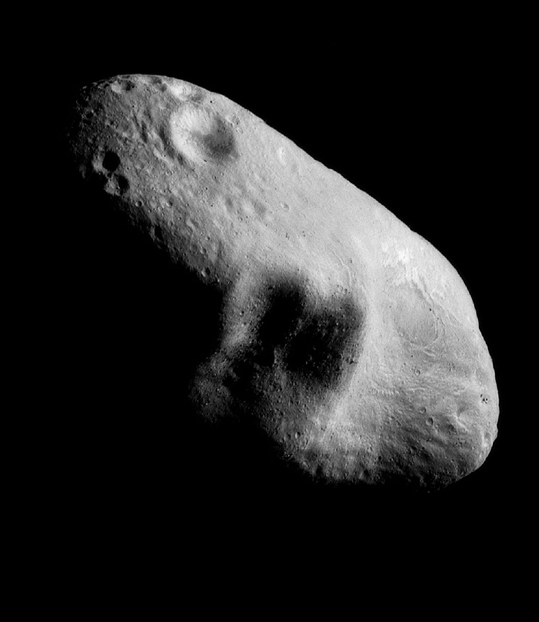2000
NEAR at Eros
Two centuries of observations since the discovery of Ceres, the first known asteroid, have led to the discovery so far of more than half a million minor planets orbiting throughout the solar system. Many orbit in the main asteroid belt between Mars and Jupiter, many orbit in the Trojan Asteroid clouds ahead of and behind Jupiter’s orbit, and many—in orbits that approach or cross that of our own planet—orbit much closer in. Members of this latter class are known as near-Earth asteroids (NEAs); about nine thousand have been found, 10 percent of which are larger than 0.6 mile (1 kilometer).
The first NEA discovered was 433 Eros, found in 1898 by German astronomer Gustav Witt and French astronomer Auguste Charlois. Eros occasionally comes close to Earth; in fact, its proximity enabled the use of parallax to make some of the first direct estimates of the astronomical unit (AU), the average distance between the Earth and the Sun. It is also one of the largest known NEAs, and while it is not currently a threat to impact the Earth, future perturbations in its orbit could make it a threatening object.
In order to learn more about Eros and NEAs in general, NASA launched a robotic mission in 1996 called NEAR—the Near Earth Asteroid Rendezvous—to fly by and then spend a year in orbit around Eros, studying the asteroid closely with CCD imaging and spectroscopy. After a flyby of 253 Mathilde, the spacecraft went into Eros orbit in 2000 and was renamed NEAR-Shoemaker, in honor of the planetary geologist and asteroid and comet hunter Eugene M. Shoemaker.
Eros is a big NEA—about the size of Manhattan island—and has a rocky density of about 2.7 grams per cubic centimeter. Its ancient surface is heavily cratered, and its color and spectrum suggests that it is made of the same primitive material as ordinary chondrite meteorites, the building blocks of the Earth and other planets.

At the end of its year-long mapping mission, NEAR-Shoemaker was guided to a gentle, low-gravity touchdown on the surface of Eros, where it rests today as a monument and a testament to early-twenty-first-century planetary exploration.
SEE ALSO Main Asteroid Belt (c. 4.5 Billion BCE), Late Heavy Bombardment (c. 4.1 Billion BCE), Arizona Impact (c. 50,000 BCE), Ceres (1801), Vesta (1807), Jupiter’s Trojan Asteroids (1906), 253 Mathilde (1997), Torino Impact Hazard Scale (1999), Hayabusa at Itokawa (2005), Rosetta Flies by 21 Lutetia (2010).
An orbital view of the near-Earth asteroid 433 Eros photographed by the Near Earth Asteroid Rendezvous (NEAR) spacecraft (left) from a distance of only 125 miles (201 kilometers). The asteroid is about 21 miles (34 kilometers) long and exhibits impact, tectonic, and erosional (landslide) features on its surface.
